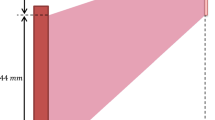Abstract
In this article, a new solution approach is developed to numerically compute large deformations of 3D hyperelastic solids based on the compressible nonlinear elasticity. The governing equations are derived by the minimum total potential energy principle, and the Neo-Hookean model is used for the hyperelastic character of material. One of the key novelties of the work is its formulation in which the tensor form of equations is replaced by an efficient matrix–vector form that can be readily utilized in the coding process. Moreover, the variational differential quadrature technique is adopted to arrive at the discretized governing equations in a direct way. Simple implementation, fast convergence rate, and computational efficiency are the main advantages of present approach. Through some examples, the accuracy and effectiveness of the proposed numerical approach are revealed.









Similar content being viewed by others
References
Belytschko T, Ong JSJ, Liu KW, Kennedy JM (1984) Comput Methods Appl Mech Eng 43:251–276
Reese S, Wriggers P, Reddy BD (2000) Comput Struct 75:291–304
Reese S, Wriggers P (2000) Int J Numer Methods Eng 48:79–109
Reese S (2002) Int J Nonlinear Sci Numer Simul 3:1–33
Kasper EP, Taylor RL (2000) Comput Struct 75:251–260
Wriggers P (2009) Mixed finite element methods—theory and discretization. Mixed finite element technologies. CISM courses and lectures. Springer, Wien, pp 131–177
Chi H, Talischi C, Lopez-Pamies O, Paulino GH (2015) Int J Numer Methods Eng 101:305–328
Lee CK, Angela Mihai L, Hale JS, Kerfriden P, Bordas SPA (2017) Comput Struct 182:540–555
Angoshtari A, Faghih Shojaei M, Yavari A (2017) Comput Methods Appl Mech Eng 313:596–631
Faghih Shojaei M, Yavari A (2018) J Comput Phys 361:247–279
Hauseux P, Hale JS, Cotin S, Bordas SPA (2018) Appl Math Model 62:86–102
Hauseux P, Hale JS, Bordas SPA (2017) PLoS One 12:e0189994
Hauseux P, Hale JS, Bordas SPA (2017) Comput Methods Appl Mech Eng 318:917–936
Breslavsky ID, Amabili M, Legrand M (2014) Int J Non-Linear Mech 58:30–40
Breslavsky ID, Amabili M, Legrand M (2014) J Sound Vib 333:4668–4681
Amabili M, Balasubramanian P, Breslavsky ID, Ferrari G, Garziera R, Riabova K (2016) J Sound Vib 385:81–92
Breslavsky ID, Amabili M, Legrand M (2016) J Appl Mech 83:051002
Amabili M, Breslavsky ID, Reddy JN (2019) Comput Methods Appl Mech Eng 346:841–861
Amabili M (2018) Nonlinear mechanics of shells and plates: composite, soft and biological materials. Cambridge University Press, New York
Faghih Shojaei M, Ansari R (2017) Appl Math Model 49:705–738
Ansari R, Hasrati E, Shakouri AH, Bazdid-Vahdati M, Rouhi H (2018) Int J Non-Linear Mech 106:130–143
Hasrati E, Ansari R, Torabi J (2018) Appl Math Model 53:653–672
Ansari R, Gholami R, Rouhi H (2019) Thin-Walled Struct 135:12–20
Ansari R, Shahabodini A, Faghih Shojaei M (2016) Compos Struct 139:167–187
Hasrati E, Ansari R, Rouhi H (2019) Int J Mech Sci 151:33–45
Shahabodini A, Ansari R, Darvizeh M (2018) Compos Struct 185:728–747
Hassani R, Ansari R, Rouhi H (2019) Int J Numer Methods Eng 118:345–370
Hassani R, Ansari R, Rouhi H (2019) Int J Non-Linear Mech 116:39–54
Elguedj T, Bazilevs Y, Calo VM, Hughes TJR (2008) Comput Methods Appl Mech Eng 197:2732–2762
Author information
Authors and Affiliations
Corresponding author
Additional information
Publisher's Note
Springer Nature remains neutral with regard to jurisdictional claims in published maps and institutional affiliations.
Appendix
Appendix
The discretization operator of \(\left[\kern-0.15em\left[ {\blacksquare } \right]\kern-0.15em\right]_{{{\mathfrak{C}}_{0} }}\) computes the elements of field of \({\blacksquare }\) at the defined computational points in the domain of \({\mathfrak{C}}_{0}\) and discretizes in block form. The computational points are defined based on the Chebyshev distribution, and are discretized in the \(X_{1}\), \(X_{2}\) and \(X_{3}\) directions as follows:
The discretized form of an arbitrary scalar field \(f\) is defined as:
whose derivatives are calculated as follows based on the numerical differentiation of GDQ [20] :
in which
Also, the numerical integration in the VDQ method is performed based on the Taylor series as follows [20]:
where \(\mathop {\mathbf{\mathcal{S}}}\limits^{1d}_{{X_{1} }}\), \(\mathop {\mathbf{\mathcal{S}}}\limits^{1d}_{{X_{2} }}\), and \(\mathop {\mathbf{\mathcal{S}}}\limits^{1d}_{{X_{3} }}\) are calculated as:
Rights and permissions
About this article
Cite this article
Ansari, R., Hassani, R., Faraji Oskouie, M. et al. Large deformation analysis in the context of 3D compressible nonlinear elasticity using the VDQ method. Engineering with Computers 37, 3251–3263 (2021). https://doi.org/10.1007/s00366-020-00959-3
Received:
Accepted:
Published:
Issue Date:
DOI: https://doi.org/10.1007/s00366-020-00959-3




